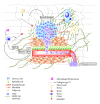Collagen VI and hyaluronan: the common role in breast cancer
- PMID: 25126569
- PMCID: PMC4121998
- DOI: 10.1155/2014/606458
Collagen VI and hyaluronan: the common role in breast cancer
Abstract
Collagen VI and hyaluronan are widely distributed extracellular matrix macromolecules that play a crucial role in tissue development and are highly expressed in cancers. Both hyaluronan and collagen VI are upregulated in breast cancer, generating a microenvironment that promotes tumour progression and metastasis. A growing number of studies show that these two molecules are involved in inflammation and angiogenesis by recruiting macrophages and endothelial cells, respectively. Additionally, collagen VI induces epithelial-mesenchymal transition that is correlated to increased synthesis of hyaluronan in mammary cells. Hyaluronan has also a specific role in cellular functions that depends mainly on the size of the polymer, whereas the effect of collagen VI in tumour progression may be the result of the intact molecule or the C5 peptide of α3(VI) chain, known as endotrophin. Collectively, these findings strongly support the parallel role of these molecules in tumour progression and suggest that they may be used as prognostic factors for the breast cancer treatment.
Figures

References
-
- Cardiff RD, Wellings SR. The comparative pathology of human and mouse mammary glands. Journal of Mammary Gland Biology and Neoplasia. 1999;4(1):105–122. - PubMed
-
- Smalley M, Ashworth A. Stem cells and breast cancer: a field in transit. Nature Reviews Cancer. 2003;3(11):832–844. - PubMed
-
- Davies JA. Encyclopedia of Life Sciences. 2001. Extracellular matrix.
-
- Ball S, Bella J, Kielty C, Shuttleworth A. Structural basis of type VI collagen dimer formation. The Journal of Biological Chemistry. 2003;278(17):15326–15332. - PubMed
Publication types
MeSH terms
Substances
LinkOut - more resources
Full Text Sources
Other Literature Sources
Medical
Miscellaneous

